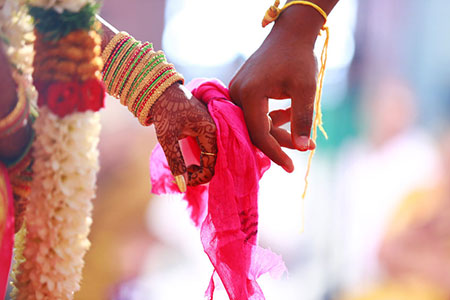The Symbolism Of Wedding Ribbons And Cords
 In a recent reading, I had visions of a wedding and a shotgun! I did my best to diplomatically convey what I was seeing to the client. I also mentioned how I saw lots of colored ribbons, and a rather large gathering of people of all ages and cultures.
In a recent reading, I had visions of a wedding and a shotgun! I did my best to diplomatically convey what I was seeing to the client. I also mentioned how I saw lots of colored ribbons, and a rather large gathering of people of all ages and cultures.
He laughed, and said that two years ago, he felt a strong urge for himself and his partner to get married. They both came from large families and wanted to make sure that certain ailing, elderly members would still be able to attend and join in the celebration.
He also said he was so glad spirit prompted them to marry sooner than later, because the pandemic would have prevented not just the large gathering of guests from attending, but also many from traveling from various corners of the world as they had done. Apparently, the ribbons I saw related to the traditional pagan handfasting they had chosen as the ceremony for their special event.
The handfasting ritual had always fascinated him, because of his own Celtic origins and he explained how both his and his partner’s hands were bound together with a ribbon during the vows and exchanging of rings. I later learned from a Pagan friend that cord is sometimes also used for this purpose in such a ceremony.
In many traditions the use of colored ribbons and cords is of spiritual significance at certain ceremonies, especially weddings. They are typically used to physically connect the couple, or they are placed in or around an altar. The cord is a symbol of the lifetime bond the couple is entering into.
For example, a wedding cord, also known as the ‘wedding lasso,’ is used in some Catholic wedding ceremonies. It typically consists of a loop of rosary beads made out of white satin or silk, and formed into a figure eight shape, and placed around the bride and the groom after they have made their vows.
The real act of marriage takes place in the heart, not in the ballroom or church or synagogue. It’s a choice you make–not just on your wedding day, but over and over again–and that choice is reflected in the way you treat your husband or wife ~ Barbara de Angelis
A similar Christian tradition is the God’s Knot or the Unity Braid ceremony using a cord of three braided strands to symbolize the joining of the two partners, as well as God, into the marriage relationship.
In Hindu weddings, cords are tied to the wrists of both the bride and the groom. Marriage is seen to be a difficult life challenge, and the cords are meant as protection.
There is also the ‘veil and cord’ tradition that originated in the Philippines. A veil is draped over the bride’s head and groom’s shoulders, and the cord tied in a loose figure eight around them. The couple will usually finish the ceremony wearing the veil and cord.
Handfasting Colors
In a Pagan handfasting, different color ribbons have their own meaning and spiritual symbolism:
Violet assists in keeping the romance going and the trust in one another, encouraging a union to be a journey of discovery about each other. It assists couples to connect on a soul level and encourages deep intimacy.
Indigo relates to intuition and to our higher self and helps in making wise decisions when dealing with any trying situations that may crop up in a committed relationship.
Purple encourages loyalty and respect between partners. Purple is not a commonly used color for handfastings, because traditionally it is used in royal or political. In such marriages the color purple would symbolize an oath to help one another in their respective duties and in the dividing of resources.
Brown is symbolic of having realistic expectations in a union, as well as being dependable. It encourages couples to keep family traditions alive, and to encourage future generations to be respectful of Mother Earth. Brown is sometimes also used when one or both partners are embarking on a second marriage. If they are unable to have children of their own, the couple will also use brown ribbons during the handfasting ceremony to signify their intention to adopt children.
Green expresses the intention to be involved in community projects or support an important cause. It also symbolizes abundance on all levels, including prosperity, happiness and health. It encourages each partner to help the other grow in confidence and healing.
Yellow symbolizes a fun and warm union, and one which inspires others. It also symbolizes a long-lasting and prosperous marriage and longevity for both partners.
Gold is symbolic of warmth in a union and in growing wiser together.
Orange symbolizes a cheerful couple who likes to socialize. It suggests playfulness. It sets the intention to be creative together, and to make time for enjoyment and pleasure. It also encourages fertility, sexuality and a sacred union.
Pink symbolizes never-ending love. It is about affection and unconditional love.
Red represents a union with passion and courage. It also relates to the base chakra and signifies being a support system for one another. It is symbolic of a couple laying firm foundations for a happy future right from the beginning of their union. It is also symbolic of all of a couple’s basic needs being met and safety.
Black is not used very frequently, but when it is, it usually suggests protection from the negative intentions of others and a promise to protect one another, as well as helping them to keep their focus positive.
Silver symbolizes a couple making wise choices when faced with decision making in their future together.
Grey is symbolic of cloudy skies and stormy weather and symbolizes couples weathering those stormy times together as a team.
White symbolizes beginning anew with transparency, pure intentions and honesty from the very start. It also symbolizes spirit and for the union be filled with the joy of spirit.
|
|

Leave a Reply